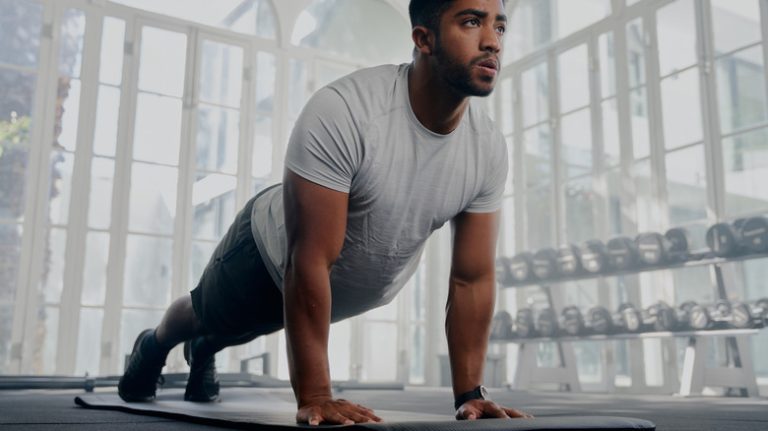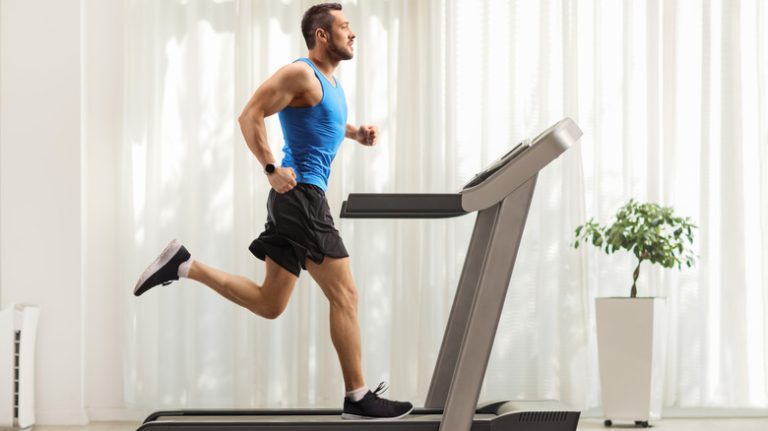Squats are a lower-body compound exercise. This means they target multiple muscle groups, requiring these muscles to work together to complete the movement. During a squat, your quads, glutes, and hamstrings are coordinating the bending and extending at the hips and knees. Additionally, your calves, core muscles, back, and shoulders help maintain proper form and alignment, protecting your joints from injury.
Compound exercises like squats offer numerous benefits. They are applicable to everyday movements. If you’re strong enough to squat in the gym, that strength translates to getting out of bed or picking something up from the ground. Moreover, as Healthline highlights, compound exercises burn more calories, improve coordination, enhance strength and flexibility, and increase muscle mass. If you incorporate squats into your daily routine, here’s what you can expect.
Is it okay to squat every day?
Squats are a weight-bearing exercise that recruits muscles throughout the body, helping train them for everyday tasks, as Ryan Andrews, a certified strength and conditioning specialist, wrote for Precision Nutrition. These muscles assist you from the moment you stand up in the morning to when you sit down at night.
However, it’s important to mix squats with other exercise forms, including aerobic activities for cardiovascular health and exercises that keep your muscles supple and flexible, according to Texas Family Fitness. Squatting every day is generally considered safe, as Rozalynn S. Frazier, a certified personal trainer, explained in Livestrong, though it’s important to consider if it detracts from other workouts, your goals, and how your body copes without rest.
You’ll build lower body muscles by squatting every day
Squats target every major muscle group of your butt (gluteus muscles), legs (hamstrings, quadriceps, calves), hips (abductors, adductors, hip flexors), and core (abdominals, spinal erectors, hip stabilizers), according to Precision Nutrition. Performing squats with proper form and full range of motion can improve muscular strength and endurance over time.
Varying your squat routine with back squats or overhead squats challenges the shoulders, arms, chest, and back muscles, as noted by Healthline. Incorporating squats into your routine can make everyday activities like climbing stairs or running after kids easier as your strength improves.
Daily squats will boost your metabolism
Squats can boost your metabolism in various ways, as explained by Self. Larger muscle groups burn more calories during workouts. Muscle is a metabolic tissue, so targeting large groups like glutes, hamstrings, and quads increases metabolism more than smaller muscles.
Building more muscle makes you stronger, enabling heavier lifting or longer hikes. As strength coach Marie Spano told Self, “Gaining muscle through resistance exercise means you can do more.” Finally, more muscle mass boosts metabolism around the clock, as strength coach K. Aleisha Fetters explained in Self, with muscle burning more calories than fat, contributing to overall energy expenditure.
You’ll strengthen your core by doing squats every day
Squats primarily target the legs, but they also require core stabilization and engagement, strengthening the abdomen and low back. However, as strength coach Avi Silverberg noted in Powerlifting Technique, squats shouldn’t replace core workouts because the core comprises various muscle groups.
Squats excel in developing erector spinae strength compared to planks, which are better for developing rectus abdominis — the “six-pack muscles.” Different exercises target the core differently. Squats are effective for building core strength overall, reducing injury risk, and improving athleticism, but they’re not the best for achieving six-pack abs.
You’ll build your bones with daily squats
Aging causes gradual thinning of bone tissue, leading to conditions like osteopenia and osteoporosis, as noted by Mount Sinai. Osteoporosis increases fracture risks, particularly in the hip or spine, leading to lifestyle changes.
Strength training exercises, including squats, are effective for maintaining bone strength and stimulating bone tissue growth. A 2013 study in the Journal of Strength and Conditioning Research found that postmenopausal women with osteoporosis who performed heavy squats three times a week for 12 weeks saw increased bone mineral content in the spine and femoral neck. The study concluded that maximal strength training is effective for patients with reduced bone mass.
Doing squats daily may reduce your risk of injury
While squats can harm your knees or cause back pain if performed incorrectly, proper squat form can help prevent injuries. A 2020 study in the Journal of Strength and Conditioning Research found that college athletes with higher relative squat strength were less likely to suffer lower extremity injuries during their athletic season.
This is due to the benefits of compound exercises like squats on lower body strength, core strength, spinal stability, control, coordination, and athleticism. The strength and coordination developed from squats are transferable to other activities, reducing injury risk.
Daily squats may improve your athletic performance
Regular squats can enhance athletic performance, as Stack notes, particularly in areas related to power, speed, and strength. Squats can develop muscles in your glutes, quads, and hamstrings, enhancing power and explosiveness.
However, squats won’t improve sport-specific skills like swinging a golf club or hand-eye coordination for softball. Strength and conditioning coach Josh Williams wrote for Stack, “There’s no proof that the squat will make you better at sport-specific skills, unless your sport is weightlifting. What the research does show is that the squat is effective at preparing your body for sports that require power output, strength, and speed.”
Switching up your squats will keep your workout interesting
Doing basic air squats daily can become monotonous, as Well+Good explains. To avoid boredom and continue seeing results, you’ll need to increase repetitions or try squat variations, as muscles grow when challenged and exposed to new stimuli.
The beauty of squats is the variety of variations available. Healthline offers 45 different variations to try, including those using added weight or no equipment. A side kick squat enhances balance and coordination while strengthening abductors, making it an excellent choice.
You’ll improve your posture by doing squats every day
Squatting helps develop core strength, particularly spinal erectors, improving posture with proper form. Certain squat variations, like overhead or front squats, strengthen shoulders and upper back, further enhancing posture.
Healthline explains that overhead squats, which involve holding a weight above your head, strengthen shoulders, arms, and upper back, as well as legs and lower back. Maintaining good form during overhead squats is crucial to avoid injury.
The actions of retracting shoulders and lifting the chest counteract poor posture culprits like forward-rounded shoulders and a forward-tilted head.
You’ll find it easier to walk up stairs after implementing a squat routine
As your lower body and core strengthen from daily squats, daily life tasks like climbing stairs or carrying groceries may become easier.
Katrina Pilkington, an NASM-certified personal trainer, told Women’s Health, “So many actions can stem from the movements of a squat, from picking up your toddler to loading boxes into the house after a delivery. If you work to perform squats on a regular basis, using form that is on-point … you’re sure to build a strong foundation for functional movement.”
Ultimately, working out should enhance functional movement, providing more energy for daily activities and workouts, leading to better results and even more energy.
You’ll need to add more weight or reps to keep seeing results
With resistance training, as you get stronger, you need to keep adding resistance to continue seeing results. That means if you’re squatting daily, you should regularly add more weight or try different variations.
Kisar S. Dhillon, a personal trainer, wrote for Active, “If you have been doing a certain weight … and you’re able to complete the sets and repetitions after two weeks, it’s time to increase your resistance.” Dhillon suggests increasing the weight you’re lifting by 5 to 10 percent.
There are ways to increase resistance without adding more weight, such as trying a front squat, overhead squat, single-leg squat, or increasing repetitions. The key is to keep varying your routine and challenging yourself. When a set and rep scheme becomes easy, it’s time to change.
Squats can make your butt and legs bigger
Strength training can lead to body changes. As you boost metabolism and burn calories, you may lose fat and gain muscle mass, adding definition to areas like glutes, hamstrings, and quads.
Kelli Segars, a personal trainer and founder of Fitness Blender, wrote, “Like many people, I used to avoid strength training because I didn’t want to ‘get bulky.’ Once I ditched that mentality and began lifting … my weight dropped, my shape changed.” She noted that squats can change the appearance, shape, and size of your butt and thighs. The outcome of regular squats is a tighter, more shapely lower body — potentially requiring new jeans to showcase your derriere.
You can improve your flexibility by doing squats daily
While strength training and flexibility may seem unrelated, moving through a full range of motion can actually improve flexibility. A study by James R. Whitehead of the University of North Dakota presented at the American College of Sports Medicine found that strength training improved hip flexibility more than stretching.
William Lunn, exercise scientist, told WebMD, “Look at Olympic weight lifters. They’re extremely powerful lifters, but they’re also extremely flexible.” Strength training, like squats, can enhance flexibility.
You can improve your balance with squats
Besides building strength and flexibility, daily squats can improve balance by choosing squat variations that focus on balance, as Body Building suggests. Single-leg squats challenge balance as your center of gravity shifts.
Using balance tools like BOSU balls also enhances balance, even on two legs, because the unstable surface engages smaller stabilizing muscles in ankles, hips, and core, as Healthline explains. To improve balance, consider squat variations using equipment or targeting one leg.
Labor and delivery might be easier thanks to squats
If you’re pregnant, squatting regularly might ease labor and delivery. Strengthening glutes, hips, and core (particularly the core) aids pushing during childbirth. NASM-certified trainer Katrina Pilkington told Women’s Health that squats strengthen the pelvic floor.
OB-GYN Kelly Morales’ website emphasizes that a strong pelvic floor is vital for a healthy pregnancy, childbirth, and postpartum recovery. “A healthy pelvic floor also makes labor and delivery less risky, as you’ll be better equipped for labor, which means less stress for your baby.”
While exercise is generally safe during pregnancy, consult your obstetrician if you’re new to exercise.
Do squats reduce body fat?
Our bodies use energy from food calories (via Medical News Today). Excess calories can increase fat stores, which help during calorie shortages. Weight loss often involves losing both fat and muscle mass (via Healthline).
Squats expend energy, contributing to weight loss. Although you can’t spot-reduce fat, squats build muscle and burn fat overall, according to Livestrong.
How long do squats take to show results?
The timeframe for seeing results depends on your definition of “results.” If your goal is well-being, results may be immediate (via Fast Company). For weight loss, you may notice changes on the scale soon after starting a squatting program, per Inspira Health Network.
Increased muscle tone may take weeks to notice, as Dark Iron Fitness points out. Results depend on body size, composition, hormone levels, and diet. Personal trainer Sarah Rector told Byrdie, “The more regularly you do squats, the more results you will see.” Generally, you’ll see results from strength training within 12 weeks, according to Kristin Haraldsdottir, director of Exercise Research & Innovation at Hydrow, told Insider.




